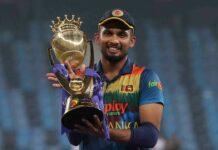With the lovely Indian Ocean on two sides, bordering the famous Dutch Fort and the town of Galle, one of the most picturesque venues in international cricket is a place of deceiving views.
>> VISIT THE #SLvZIM HUB <<
Hidden behind the panorama, Galle has been a fortress for the Lions ever since it hosted its first Test in 1998. Out of the 29 Tests played there, Sri Lanka has won 17, drawing and losing a mere 6 apiece.
However the citadel is little known for hosting ODIs. Understandingly so, the venue has not been site for the shorter format since 2000. With the Zimbabwean side scheduled to tour the Emerald Isle, ODI cricket will return to the Galle International Stadium after 17 long years.
Known for its Test cricketing folklore, rarely is narrated about its ODI tales, facts or figures.
It started with the rain
A fortnight after hosting its first Test, which saw an emphatic innings and 16 run win for Sri Lanka against a touring New Zealand side, the venue was ready to host its first ODI on 25th June 1998. As a part of the Singer-Akai Nidahas Trophy triangular series between Sri Lanka, India and New Zealand, the two neighbours were scheduled to face each other but the match was washed out due to heavy overnight rain. Torrential rains continued for the next four days, abandoning two further matches in the tri series, forcing the series to be decided from the games played at Colombo. Galle would not host an ODI for another year.
Aiwa Cup 1999
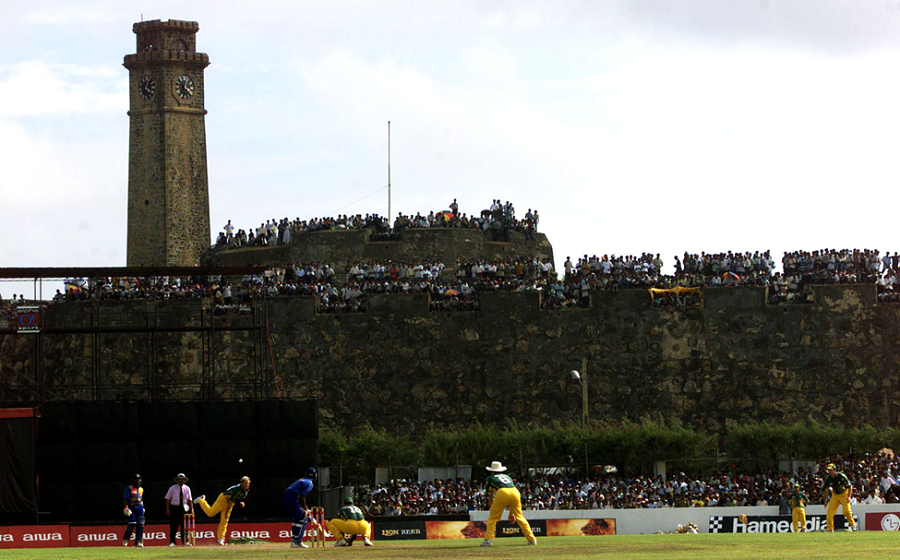
One of the most famous and nostalgic memories among old school cricket fans was the Aiwa Cup 1999, a tri series involving Sri Lanka, India and recent crowned world champions Australia. The final was best remembered for Sri Lanka ending Australia’s 11 game unbeaten streak in ODIs. The series began with two ODIs in Galle. On 22nd August, Sri Lanka faced Australia in the first game. Winning the toss, Captain Sanath Jayasuriya elected to field first. Mark Waugh and Adam Gilchrist set up an opening stand of 60 in 10 overs when Gilchrist was controversially given run out by the TV umpire. Following a throw from deep square leg by Mahela Jayawardene, there was contention whether Romesh Kaluwitharana had dropped the ball and the Australian opening batsman had grounded his bat behind the line. Again, weather hampered proceedings, but less severely than the previous year with the match being reduced to 43 overs. Three crucial scalps by Jayasuriya saw Ricky Ponting and Tom Moody stumped by Kaluwitharana and opposition skipper Steve Waugh being rattled for 6. However Michael Bevan initiated a trademark revival with 42 in 44 deliveries, taking Australia to a fighting 205/9. Jayasuriya took 5 for 28.
Sri Lanka’s pursuit was impeded by Damien Fleming and Jason Gillespie. Jayasuriya was removed by Fleming in the 2nd over while Gillespie’s eventual 3 for 26 sent Avishka Gunawardene, Marvan Atapattu and Mahela Jayawardene back to the hut for single digits, leaving the home team on 41/4. A grappling middle order, despite fighting knocks of 33 by Kaluwitharana, 30 from Upul Chandana and 26 by Suresh Perera, never recovered. The chase ceased at 160, giving a 50 run win to the visitors.
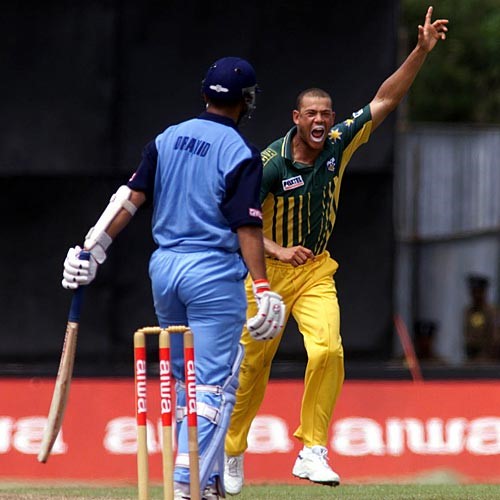
On the following day, Australia recorded a convincing 8 wicket win against India, again, in a rain hampered encounter. The 38 over game saw India scoring 151/7. Australia’s chase was braced by a 132 run partnership between Adam Gilchrist and Andrew Symonds, each scoring 68, in a victory sealed in 30 overs.
Singer Triangular Series 2000 – “The Galle Miracle”
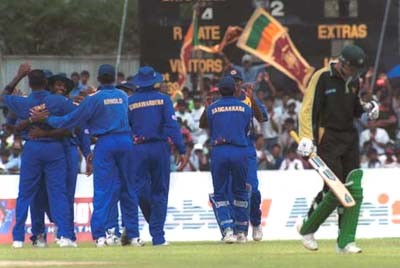
Another memorable tri series on Sri Lankan soil came in 2000, between Sri Lanka, Pakistan and South Africa. Two opening games were scheduled at Galle, involving Sri Lanka against Pakistan and South Africa.
On 5th July 2000, Sri Lanka took on Pakistan. The team featured a relatively unknown debutant, Kumar Sangakkara, who would go on to become one of the greatest batsmen of all time. The match was reduced to 45 overs due to rain. Batting first, Pakistan were reeling at 53/6 with early damage by Nuwan Zoysa who claimed 4 for 34, his career best. Inzamam-ul-Haq dazzled with 83 despite being retired hurt at one point, taking Pakistan to 164/8 in 45 overs. Being on 19/2, Atapattu rallied with 62, later joined by Sanga who made 35 valuable runs with classy strokeplay to take Sri Lanka home in 38 overs with 5 wickets in hand.
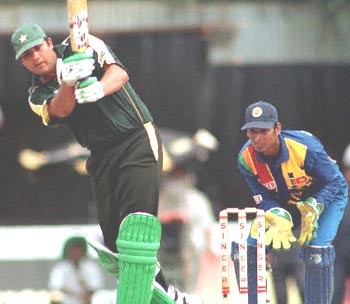
Next day, Sri Lanka hosted South Africa in the second ODI. For the first time, there was a complete 50 over encounter at the venue. Put in to bat by the visitors, Sri Lanka had an onerous start. Jayasuriya was run out by Andrew Hall in the second delivery of the match. He was soon followed by Atapattu and Jayawardene, leaving the hosts on 35/3. In came Kumar Sangakkara to join Avishka Gunawardene as they added 66 runs for the 4th wicket. After the opener departed for 47, Sanga displayed a great deal of maturity, stimulating the momentum with Russel Arnold. The pair annexed a 120 run stand before Sanga was run out for an elegant 85. Being run out on his debut on the previous day as well, no doubt the youngster was vexed, missing out on a well-deserved century. Arnold continued, remaining unbeaten on 59 as Sri Lanka reached 249/7 in 50 overs. Jacques Kallis took 3 for 42.
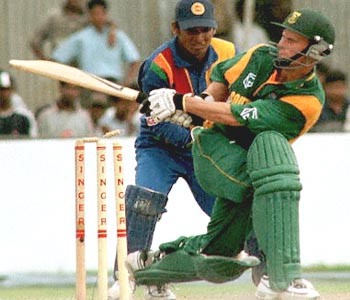
Chasing down 250 runs, Gary Kirsten and Andrew Hall amassed a 150 run stand in 32 overs for the opening wicket, shattering hopes for Sri Lanka. With a mere 100 runs to get they were in overdrive, until Muralitharan rattled Kirsten for 59. Andrew Hall followed three overs later with a return catch to Upul Chandana. His stellar 81 included six fours and three giant sixes. Upul Chandana who dismissed Hall, ran riot through the line-up. After Dharmsena sent Kallis off for 11, Chandana removed Jonty Rhodes for a golden duck before claiming Daryll Cullinan for 14 with a catch to substitute fielder TM Dilshan. Sri Lanka’s brilliance on the field narrated its own tale when Jayasuriya and Atapattu forced three run outs to send Lance Klusener, Mark Boucher and Makhaya Ntini back to the dressing room. A miracle was unveiling amidst the boisterous Galle crowd support as the final 9 wickets of South Africa fell for a mere 62 runs, sealing a momentous 37 run win for Sri Lanka. Upul Chandana took 4 for 44. Sri Lanka eventually went on to win the triangular series in Colombo.
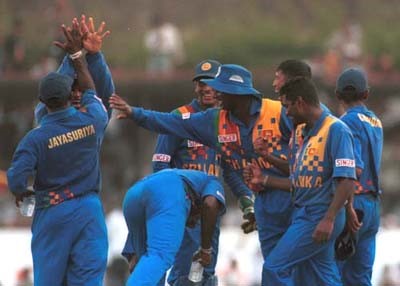
Facts and figures
Rain has hampered most games at Galle since its debut. With 3 abandoned games to begin, Galle has hosted 4 ODIs, although only one has been played as a complete 50 over game, the last ODI played at the venue between Sri Lanka and South Africa in 2000.
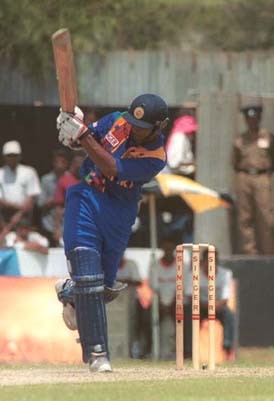
- Most wins – Sri Lanka and Australia (2 each)
- Highest team total – 249/7 (Sri Lanka vs South Africa, 2000)
- Lowest total – 160 (Sri Lanka vs Australia, 1999)
- Largest victory (by runs) – 50 runs (Australia vs Sri Lanka, 1999)
- Largest victory (by wickets) – 8 wickets (Australia vs India, 1999)
- Most runs – Kumar Sangakkara (120 runs in 2 innings) (Avg. 60.00)
- Most runs (non SL) – Adam Gilchrist (95 runs in 2 innings) (Avg. 47.50)
- Highest individual score – Kumar Sangakkara (85 vs South Africa, 2000)
- Highest partnership – 150 runs (Gray Kirsten, Andrew Hall) South Africa vs Sri Lanka, 2000)
- Most wickets – Jason Gillespie (5 wickets in 2 innings) (Avg. 11.20), Sanath Jaysuriya (5 wickets in 3 innings) (Avg. 12.40)
- Best bowling – Sanath Jayasuriya (5 for 28 vs Australia, 1999)
- Most dismissals – Mark Boucher, Romesh Kaluwitharana, Adam Gilchrist (3 each)
- Most catches – Upul Chandana (4)
After 17 years, ODI cricket has returned to Galle and there is no doubt that the fans are hoping to see the venue adorned in coloured clothing, white balls and black site screens more often in the future.




